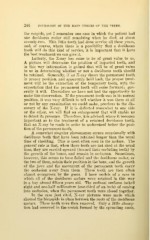Page 392 - My FlipBook
P. 392
246 PATHOLOGY OF THE HABD TISSUES OF THE TEETH.
the cuspids, yet I remember one case in which the patient had
one deciduous molar still remaining when he died, at about
seventy-two. This little tooth had done service all these years,
and, of course, where there is a possibility that a deciduous
tooth will do this kind of service, it is important that it have
the best treatment we can give it.
Latterly, the X-ray has come to be of great value to us.
A picture will determine the position of impacted teeth, and
in this way information is gained that will be of great value
to us in determining whether or not a deciduous tooth should
be retained. Generally, if an X-ray shows the permanent tooth
in proper position, and apparently held back, the proper treat-
ment will be the extraction of the temporary tooth, with the
expectation that the permanent tooth will come forward; gen-
erally it will. Heretofore we have not had the opportunity to
make this observation. If the permanent tooth was in its normal
position, it was very difficult to tell whether it was there at all
or not by any examination we could make, previous to the dis-
covery of the X-ray. If it is deflected somewhat to one side
or the other, we will find an enlargement that will enable us
to detect its presence. Therefore, it is advised, where it becomes
important as to the treatment of a retained deciduous tooth,
that an X-ray be made in order to understand better the posi-
tion of the permanent tooth.
A somewhat singular phenomenon occurs occasionally with
deciduous teeth that have been retained longer than the usual
time of shedding. This is most often seen in the molars. The
general rule is that, when these teeth are not shed at the usual
time, they are carried upward (toward their occluding teeth) by
the growth of the bones, and remain in occlusion. Sometimes,
however, this seems to have failed and the deciduous molar, or
the two of them, retain their position in the bone, and the growth
of the jaws and the movement of the permanent teeth carry
the occlusion away from them. These teeth are then often
almost overgrown by the gums. I have models of a case in
which all of the deciduous molars were retained in this way
in a boy almost fifteen years old. The occlusal surfaces lacked
eight and one-half millimeters (one-third of an inch) of coming
into occlusion, when the permanent teeth were closed together.
In the case just cited, X-ray pictures were made which
showed the bicuspids in place between the roots of the deciduous
molars. These teeth were then removed. Only a little absorp-
tion had occurred in the crotch formed by the spreading roots,


